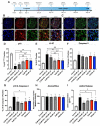Senolytic Combination Treatment Is More Potent Than Single Drugs in Reducing Inflammatory and Senescence Burden in Cells from Painful Degenerating IVDs
- PMID: 37627322
- PMCID: PMC10452201
- DOI: 10.3390/biom13081257
Senolytic Combination Treatment Is More Potent Than Single Drugs in Reducing Inflammatory and Senescence Burden in Cells from Painful Degenerating IVDs
Abstract
Background: Low back pain is a global health problem directly related to intervertebral disc (IVD) degeneration. Senolytic drugs (RG-7112 and o-Vanillin) target and remove senescent cells from IVDs in vitro, improving tissue homeostasis. One drawback of using a single senolytic agent is the failure to target multiple senescent antiapoptotic pathways. This study aimed to determine if combining the two senolytic drugs, o-Vanillin and RG-7112, could more efficiently remove senescent cells and reduce the release of inflammatory factors and pain mediators in cells from degenerating human IVDs than either drug alone.
Methods: Preliminary data evaluating multiple concentrations of o-Vanillin and RG-7112 led to the selection of four treatment groups. Monolayer and pellet cultures of cells from painful degenerate IVDs were exposed to TLR-2/6 agonist. They were then treated with the senolytics o-Vanillin and RG7112 alone or combined. p16ink4a, Ki-67, caspase-3, inflammatory mediators, and neuronal sprouting were assessed.
Results: Compared to the single treatments, the combination of o-Vanillin and RG-7112 significantly reduced the amount of senescent IVD cells, proinflammatory cytokines, and neurotrophic factors. Moreover, both single and combination treatments significantly reduced neuronal sprouting in rat adrenal pheochromocytoma (PC-12 cells).
Conclusions: Combining o-Vanillin and RG-7112 greatly enhanced the effect of either senolytic alone. Together, these results support the potential of senolytics as a promising treatment for IVD-related low back pain.
Keywords: cellular senescence; combination therapy; intervertebral disc degeneration; low back pain; senolytics; senotherapeutics.
Conflict of interest statement
The authors declare no conflict of interest.
Figures





Similar articles
-
Plant-Derived Senotherapeutics for the Prevention and Treatment of Intervertebral Disc Degeneration and Aging.Metabolites. 2024 Feb 28;14(3):146. doi: 10.3390/metabo14030146. Metabolites. 2024. PMID: 38535306 Free PMC article. Review.
-
Senolytic treatment for low back pain.Sci Adv. 2025 Mar 14;11(11):eadr1719. doi: 10.1126/sciadv.adr1719. Epub 2025 Mar 14. Sci Adv. 2025. PMID: 40085710 Free PMC article.
-
Toll-like receptor 2 induced senescence in intervertebral disc cells of patients with back pain can be attenuated by o-vanillin.Arthritis Res Ther. 2021 Apr 16;23(1):117. doi: 10.1186/s13075-021-02504-z. Arthritis Res Ther. 2021. PMID: 33863359 Free PMC article.
-
Senotherapeutic drugs for human intervertebral disc degeneration and low back pain.Elife. 2020 Aug 21;9:e54693. doi: 10.7554/eLife.54693. Elife. 2020. PMID: 32821059 Free PMC article.
-
For whom the disc tolls: intervertebral disc degeneration, back pain and toll-like receptors.Eur Cell Mater. 2021 Mar 19;41:355-369. doi: 10.22203/eCM.v041a23. Eur Cell Mater. 2021. PMID: 33738788 Review.
Cited by
-
Gut aging: A wane from the normal to repercussion and gerotherapeutic strategies.Heliyon. 2024 Sep 12;10(19):e37883. doi: 10.1016/j.heliyon.2024.e37883. eCollection 2024 Oct 15. Heliyon. 2024. PMID: 39381110 Free PMC article. Review.
-
Plant-Derived Senotherapeutics for the Prevention and Treatment of Intervertebral Disc Degeneration and Aging.Metabolites. 2024 Feb 28;14(3):146. doi: 10.3390/metabo14030146. Metabolites. 2024. PMID: 38535306 Free PMC article. Review.
-
Therapeutic effects of PDGF-AB/BB against cellular senescence in human intervertebral disc.Elife. 2025 Jul 16;13:RP103073. doi: 10.7554/eLife.103073. Elife. 2025. PMID: 40668091 Free PMC article.
-
Therapeutic effects of PDGF-AB/BB against cellular senescence in human intervertebral disc.bioRxiv [Preprint]. 2025 Mar 27:2024.10.11.617862. doi: 10.1101/2024.10.11.617862. bioRxiv. 2025. Update in: Elife. 2025 Jul 16;13:RP103073. doi: 10.7554/eLife.103073. PMID: 39416006 Free PMC article. Updated. Preprint.
-
Senolytic treatment for low back pain.Sci Adv. 2025 Mar 14;11(11):eadr1719. doi: 10.1126/sciadv.adr1719. Epub 2025 Mar 14. Sci Adv. 2025. PMID: 40085710 Free PMC article.
References
-
- Global Burden of Disease Study 2013 Collaborators Global, regional, and national incidence, prevalence, and years lived with disability for 301 acute and chronic diseases and injuries in 188 countries, 1990–2013: A systematic analysis for the Global Burden of Disease Study 2013. Lancet. 2015;386:743–800. doi: 10.1016/S0140-6736(15)60692-4. - DOI - PMC - PubMed
Publication types
MeSH terms
Substances
Grants and funding
LinkOut - more resources
Full Text Sources
Research Materials

